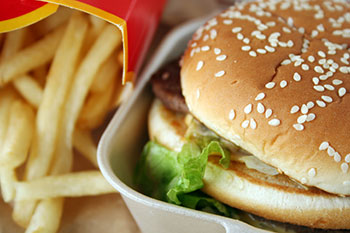More Health and Nutrition Bites
Related
Comparing the cost of meatless and non-meatless diets
Fast food restaurants have been implying for years that they're improving the healthfulness of their foods, calling them "wholesome," "fresh," and "natural." But does that really mean that they're better for you than they used to be?
Not Much Better (But at Least No Worse) Redux: Processed Food Edition
A couple of months ago I reported on a survey of the healthfulness of fast food restaurant foods. The study found that when compared to the US Government's recommendations for a healthy diet, overall the healthfulness of fast foods had increased by a mere 3% overall over the last fourteen years while still averaging less healthy than the average American's diet.
Can we reverse the effects of 'supersizing'?
It's pretty obvious that portion sizes - that is, the amount of food presented to an individual as an appropriate amount for one person to consume at a given eating occasion - has grown significantly in the last few decades. We've seen that this is true in assessments of serving sizes as presented in The Joy of Cooking, a popular cookbook in the United States, as well as in estimates of "ideal" serving sizes in the United Kingdom.
Health & Nutrition Bites
Get the latest health and diet news - along with what you can do about it - sent to your Inbox once a week. Get Dr. Gourmet's Health and Nutrition Bites sent to you via email. Sign up now!
Fast foods not just bigger

People are eating far more fast food now than they did in 1978, when an estimated 4% of all calories consumed in the United States was fast food. Now that number is 11%, and 40% is the most recent estimate I've seen of the percentage of Americans over 20 who are obese.
Over ten years ago I reported on a study that surveyed portion sizes of foods across America, from sit-down restaurants to fast food joints to meals eaten at home. Yes, portion sizes were getting bigger - and they still are, at least at fast food restaurants.
Not only that, they're getting saltier.
Researchers compared the 2016 menus and nutrition information for 10 fast food restaurants - Arby's, Burger King, Carl's Jr., Dairy Queen, Hardee's, Jack in the Box, KFC, Long John Silver's, McDonald's, and Wendy's - with the same information published in 1991 and 1986 (J Acad Nutr Diet 2019;119(6):923-933).
Not only did they look at nutrition information, they also looked at the total number of items offered, excluding beverages such as sodas and condiments. Interestingly, the sheer number of entrees, sides, and desserts (with milkshakes being considered desserts), more than doubled between 1986 and 2016.
The average entree item increased in size by 13 grams per decade - a little over 1.3 ounces total. The average dessert item increased even more, growing 24 grams per decade (about 2.5 ounces total), while the average side stayed about the same.
As you might expect, calories increased as well, with desserts increasing by 62 calories per decade and entrees by 30 calories per decade.
But the worst news is that the foods contained more sodium, with the amount increasing by 4.6% of the Recommended Daily Value, or 92 milligrams, in entrees; 3.9% in sides, or 78 milligrams; and even increasing in desserts by 1.2%. Those percentage increases remained even when the authors calculated the amount of sodium per calorie in the foods: the increase was not comparable to the increase in portion size alone.
What this means for you
Not only is fast food bad for you, it's actually worse for you than it used to be. If you find yourself stuck eating at such places, visit their website first to find out which items have the fewest calories and the least amount of sodium. Or check out our recommendations at our Eating Healthy at Fast Food Restaurants guide.
First posted: May 29, 2019
